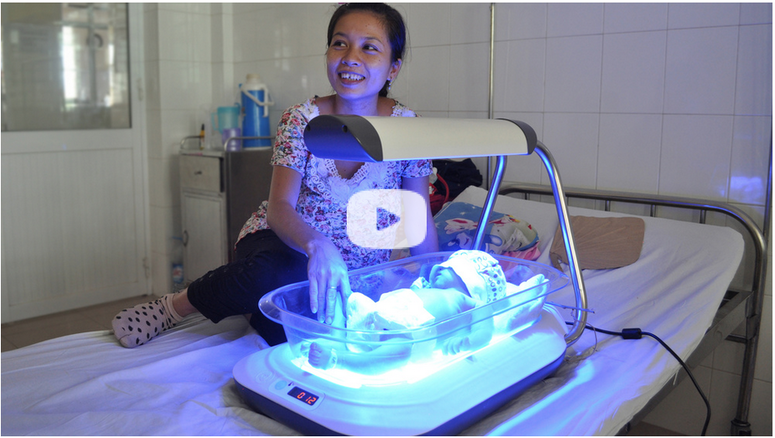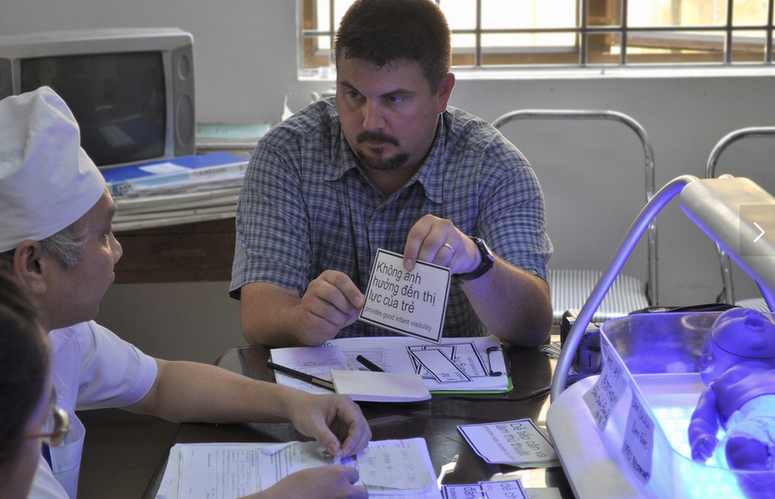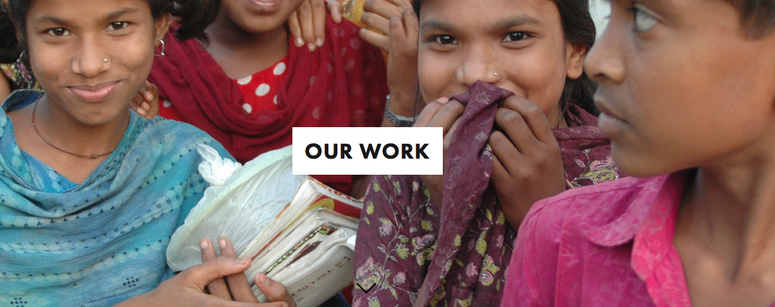What if the future were distributed more evenly by design?
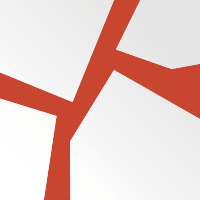
24.02.2015 Features
In the second segment of the interview series with key speakers for the 2015 IDC Eeum Design Connects event in Gwangju Korea, Don Ryun Chang, Organizing Chair of the conference chats with Timothy Prestero, founder and CEO of the award winning social impact organization Design That Matters, a non-profit design company and a leader in user-centered, context-appropriate design for social impact. He received M.S. degrees in Mechanical and Oceanographic Engineering from the MIT, and a B.S. degree in Mechanical Engineering from the University of California at Davis. He is a Martin Fellow at the MIT Laboratory for Energy and the Environment, a Draper Richards Kaplan Fellow, and was named an Ashoka Affiliate in 2004. His awards include the 2007 Social Venture Network Innovation Award, and the 2009 World Technology Award.
Don: Can we start by introducing the key agenda for Design That Matters this year?
Timothy: If I had to summarize it into something punchy, I'd say it's “one to many.” Design that Matters has been around for a long time, but Firefly’s Photo Therapy has been by far our most successful project.
"Firefly was a wonderful integration of everything we learned about human factors research, industrial design, manufacturing, and distribution. It has all come to together and it has worked. It’s the world’s most effective therapy device and the reception has been incredible."
Design that Matters supporter Solidworks created a video about DtM's Project Firefly Infant Phototherapy. The video describes the product design process and features incredible footage of Firefly in Vietnam.
We actually had a doctor in a country that I will not name, steal Firefly. That’s about the best testimonial. We have this sort of high gear results for programs. People say they like it, people demonstrate that they like it, and then there is statistically significant evidence that people like it. Then we realize that there is this other category that people like it so much they steal it. In this case he didn’t technically steal it, but took the device home to treat his sister’s baby. That’s a pretty significant professional risk.
"The statistics from the WHO show that only 30% of the medical device donations in the developing world are ever even turned on, and here we've got a device that they love so much that they are taking it right out of the the hospital to their home. I feel like that’s a great result."
Don: For our event in October, how would you like to use that platform to pursue your agenda on advocating how technology, social impact, design and also providing for the needy can all integrate?
Timothy: My background is in engineering and I realized that engineering is rarely the problem in this kind of adaptation or for solving problems in developing countries. There is a great quote by William Gibson:
“The future is already here it’s just not distributed very evenly.” As designers we have the opportunity to better, more evenly 'distribute the future' by making these technologies and breakthroughs more accessible to more people ...I am still learning the language and culture of design. I’m sort of late to the party."
The Eames philosophy was “the best for the most for the least” I don’t know if that’s what’s called for, but what is the equivalent? The Eames were great popularizers of consumer goods, but in medicine in general, and global health in particular, I’m not sure all of the practices that accumulated over the years in design are appropriate. We’ve had some products displayed at the Cooper Hewitt, the National Design Museum, and the feedback is often about perceived aesthetic shortfall, like “the adaptation is great, but can’t it also be beautiful?” I think there is a conversation there. I am no great design theorist, but my impression is that there is a lot of design practice that comes that is based in assisting companies differentiate consumer goods in mature markets. And so aesthetics become critical. If a mop is a mop is a mop, you know, for me to help sell a new mop, then aesthetics is a pretty big deal, because otherwise it’s just another mop.
Timothy was a Peace Corps volunteer in Côte d'Ivoire, West Africa, and he has led design and global projects in 20 countries across Africa, Latin America and Asia.
What is design? Steve Jobs said: "design is how it works." What’s the most broad conversation that we could have about what design is in this context?
"When are we like engineers who are forever tripped up by embedded assumptions? We see medical devices that fail to translate from an American hospital to a Vietnamese hospital just because engineers assume that all hospitals have smooth floors and working elevators. But what are the assumptions that we carry as designers?"
Engineers just don’t even know that those are bad assumptions. You’ve heard the joke that there’s these two baby fish swimming around in the lake. And an adult fish swims by, and says, “Hey guys, how’s the water?” And the baby fish are like, “What? What’s water?” So I think that for a lot of designers it’s easy to criticize engineering for being blinded to assumptions. The assumption for designers, however, is that aesthetics only means beautiful.
Don: You’ve experienced these gaps in many parts of the world. In order to effectively engage with different audiences, how do you make them aware of the many different situations and encourage different types of collaboration?
Timothy: If somebody asked me to summarize the difference between design and engineering, I would say that design is empathy.
"There is a great line where you can be right or you can have empathy. But you can’t have both. I think that needs to be the starting point for engaging students or the industry."
To have empathy. By that I mean the willingness to step outside of whatever brain works, assumptions, or paradigms that we are comfortable within and try to imagine the world from somebody else's perspective. That’s very difficult. But I think that is the starting point for any successful design.
Don: You mentioned students. You know when they are doing many projects and searching for appropriate themes, a lot of them are sometimes corporate-oriented, but sometimes a lot of new projects are sometimes related to social innovation. How do you want them to look at organizations, such as Design That Matters? How do you think your organization can inspire and embed social design ideas to students thinking what their role can be in society for the future?
Timothy: First of all, just to show how low the bar is, the kinds of projects we are working on, for example adapting a pulse oximeter to community health workers and rural health clinics, are really not rocket science. We’ve got a device that is designed to use consumables, meaning the probes are disposable. And there is nothing that says that the probe has to be disposable. There’s no functional parameter that requires disposability. It’s really a business parameter. Because of disposable sensors, you are going to use a thousand of those a year, and that’s $35,000 in revenues.
"A company loves a renewable revenue. It’s like razor blades.The point that I try to make with students is that you don’t have to boil the ocean."
A lot of student projects start with just incredibly complex issues, where it’s clear that design alone is not the obstacle. Popular student projects are on cook stoves, water pumps and better toilets. There isn’t a poor community in the world that hasn’t had the opportunity to experience with a cook stove, latrine or water pumps. The lack of adoption has nothing to do with the ergonomics or the shape for better. There is a lot of very complex, social dynamics that really dictate adoption. So I think there is a opportunity to start with problems that are little more clearly defined.
"Rather than saying, “I’m going to create something that is going to lead to this major change in adoption,” I would say, find something that people are already using and struggling with. And then just make it easier. For a student, that is a great place to start. That’s my company’s whole business."
LOOK AT DtM's work and portfolio aimed at setting the standard for best practice in design for poor communities in the developing world.
Don: An important theme for our event is multidisciplinary collaboration. You were trained as an engineer at MIT. You also came into contact with many different disciplines and expertise. How do you foresee your organization realizing many different agendas with so many different participatory collaborations?
Timothy: I think one of the big challenges for the design field, is the perceived simplicity. I was just talking with our manufacturing partner on some of the feedback about Firefly. So Firefly was designed to go into the mothers’ rooms, which is sort of new territory for this kind of medical device. We made it small so that it could go into mothers’ beds. And if it wasn’t allowed in the mother’s bed, it’s also small enough to go in this small standard cart - this standard cart, bassinet, or baby cart that you find all over the world. It was fascinating to them to have them saying, “people really love it and it’s amazing just by luck that it just fits into the baby cart!” Luck? What are you talking about? We spent a lot of time figuring out what size this thing ought to be and measuring all these crazy baby carts in all these different hospitals.
Somebody goes into Stanford D School and a MBA student takes a design class and they say, “Oh, well, I can do design now. You know I read a book on design so we do not need a designer because I understand it now.” I think that’s one of the challenges of multidisciplinary teams. Nobody looks at engineering and says, “Oh I read a book about that, so I’m ready to figure out all the stresses and strains in this hinge.” But in design, there is this sense that “Oh well, good design is really obvious.” Omar Bradley said “Simplicity on this side of complexity has no value at all? But simplicity on the other side of complexity I’ll pay whatever it costs.”
"I think what designers deliver is simplicity on the other side of complexity. I think an obstacle to multidisciplinary teams is that there isn’t necessarily an awareness of just how hard it is to be simple."
The mathematician Hilbert once said that “framing the problem, a well-posed problem, is 80 percent of the work” and that’s what great design delivers: the insights and synthesis of all of this stuff that makes the answer obvious. I think I have seen a lot of neurotic industrial designers that feel like the world just doesn’t recognize or appreciate their contribution.
Don: You have a great track record. What do you foresee will be the lasting legacy for Design That Matters? How do you want your organization to evolve or be remembered in the future?
Timothy: I think the most lasting legacy is the fact that we’ve had 1,200 students and professional volunteers work on Design That Matters projects. One of the challenges with volunteer programs is that it’s easy to have a very large program, but people come away having learned the wrong lesson. Say that there is a volunteer program where you go into a poor community and you build a house as a volunteer. Is it about building the best possible house or is it about volunteers having a fun experience?
I’m really happy that the 1,200 volunteers who work for Design That Matters share the things that they are best at. So if there were lawyers volunteering for Design That Matters and they were helping us with intellectual property, contracts or medical device regulations, and there were engineers contributing their engineering - all of them would have come away saying “I have something to offer.”
You read a statistic about people affected by the Tsunami in Bangladesh or newborn mortality statistics in China and it seems as if there’s nothing I can do.
"I’m happy and proud of the fact that now there are these 1,200 volunteers who have seen that actually with incredibly valuable professional skills, I can make a contribution. We’ve actually seen people change their careers as a result of this."
I think that that whatever I’m going to do at my life is going to be modest at best, but if some percentage of these 1,200 people choose to take those incredibly valuable skills and question that direction that is a phenomenal result.
Don: The 1,200 volunteers number is a great achievement. That’s a tribute to how you shared this vision and cause and it’s really a great, remarkable number.
Timothy: Well you know, it’s modest compared to the size of the problem. It’s kind of a drop in the bucket but we are getting somewhere.
Don: Thank you Timothy!
For more more information and regular event updates:
Visit the and the Congress website: 2015idc.org
* The views and opinions expressed herein are those of the author and do not necessarily reflect those of ico-D.
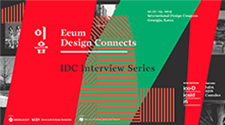
relatedarticles

goodbye! and next steps for colleague and friend alexey lazarev

explorations in ethical design: meditations on equality

RCA launches new programme: MA Digital Direction

Interview | Ermolaev Bureau (Moscow)

